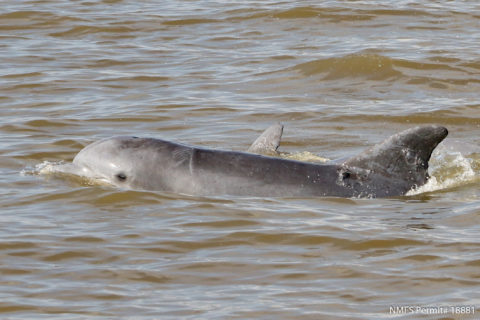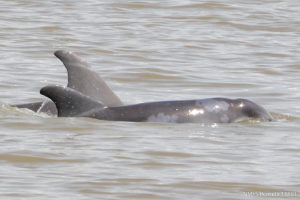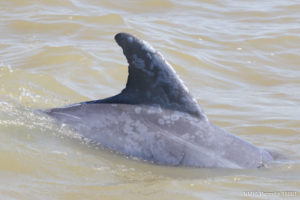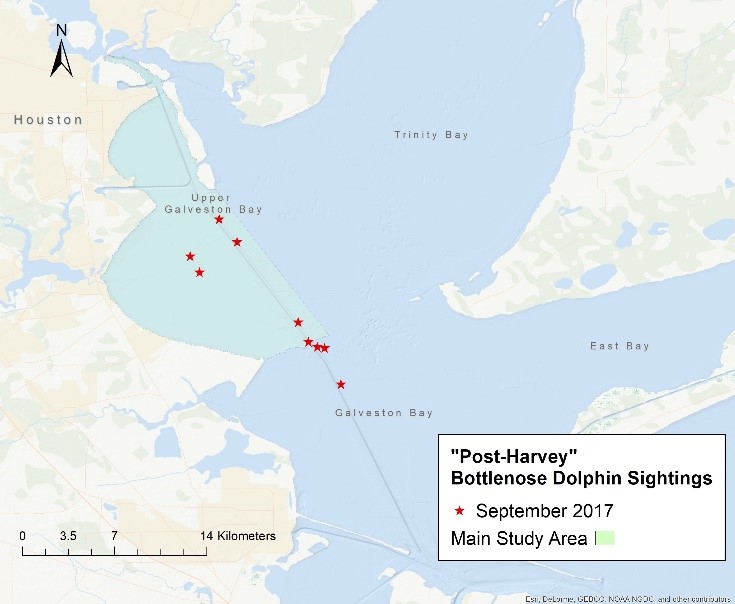Evaluating the Impacts of Hurricane Harvey on the Dolphins of Galveston Bay
- December 10, 2019
- News
 Prepared September 18, 2017
Prepared September 18, 2017
By Vanessa Mintzer, Ph.D. (Galveston Bay Foundation) and Kristi Fazioli (Environmental Institute of Houston-UHCL)
Dolphins and Hurricanes
Opportunities to evaluate the effects of catastrophic events, like hurricanes and flooding, on dolphins are rare. However, because hurricanes cause dramatic environmental changes, they are expected to impact most aquatic organisms, including these top-level predators. Dolphins that inhabit areas directly in the path of a hurricane may be immediately impacted by physical disturbances such as waves, winds, storm surge, and debris. In the weeks or months following a storm, environmental changes that may affect dolphins include low salinity, low dissolved oxygen levels, and increases in water contaminants (sewage, industrial chemicals, fertilizers, etc.). These changes may affect dolphins directly (e.g. skin sensitivity in low salinity) or indirectly (e.g. low prey availability due to the exodus of marine fishes).
Observations after other hurricanes suggest that dolphins may be initially displaced from nearshore habitats after storms and flooding, but may return after water quality normalizes and fish return. In Mississippi Sound, post-Katrina, researchers observed short and long-term effects from the storm including higher calf mortality (that was compensated later by higher-reproductive rates), a slight increase in the number of juvenile strandings, and changes in feeding behavior and locations.
In the Bahamas, following two hurricanes, 30 percent of dolphins that were regularly seen disappeared and were later replaced by other dolphins. A study conducted in Florida, after hurricane Charley, showed no long-term effects on a dolphin population in Charlotte Harbor, as population abundance, distribution, and site fidelity were back to pre-Charley numbers two years after the storm. How dolphins fare after a catastrophic event is likely to vary considerably between locations and will depend on both the resilience of the population and of the ecosystem, as well as the severity of the event. The potential negative impacts from a hurricane on estuarine ecosystems are compounded by the accidental release of hazardous materials that are more likely in an industrialized urban area.
Harvey and Dolphins in Galveston Bay
When Harvey arrived in Texas in August 2017, it became the wettest hurricane ever recorded to have made landfall in the continental United States, as rain accumulation peaked at 51.88in. This pulse of freshwater received by the Gulf of Mexico and its coastlines exceeded the volume of water of the entire Chesapeake Bay. Because the brunt of the rainfall took place on the Texas coast, including the Galveston Bay watershed, Galveston Bay has received an unprecedented volume of freshwater. This freshwater has not only changed the salinity of the Bay, but has likely contaminated the Bay with waterborne pathogens and toxic chemicals (possibly dioxins from a compromised Superfund site or resuspended channel sediments). Consequently, the most pressing issues surrounding the dolphin’s health and ecology is their ability to tolerate low salinity, exposure to contaminants in the water, as well as changes in prey availability.
The Galveston Bay Dolphin Research and Conservation Program (GDRCP) is in a unique position to evaluate the effects of Hurricane Harvey on Galveston Bay bottlenose dolphins (Tursiops truncatus), and contribute to this imperative area of research. The GDRCP has been monitoring the upper Galveston Bay dolphin population since 2013, allowing for multiple year comparisons of pre and post Harvey data. With over 550 identified cataloged dolphins, the GDRCP has the opportunity to evaluate Harvey’s effects on both the population as a whole, and its individuals.
Prior to Harvey, Galveston Bay dolphins had already shown vulnerability to increases in freshwater inflow.
Since the GDRCP has monitored the dolphin population, researchers have observed skin lesions on some individual following heavy rain events. These lesions could be caused by sensitivity to changes in salinity and/or exposure to pathogens and chemicals from toxic runoff. The GDRCP has been compiling data on these skin lesions and has been working in collaboration with the National Marine Fisheries Services and other programs on the Gulf coast to better understand their causes and significance.
On Wednesday, September 6 (roughly 10 days after the rain from Harvey seized), the GDRCP was able to conduct its first boat survey in Galveston Bay. The research crew found few dolphins in upper Bay, and traveled south in search for more.
The absence of dolphins in most of the upper Bay region was in stark contrast to observations from previous years during the same time frame and to the weeks preceding Harvey, when dolphins were seen in high numbers throughout the study area (Figure 2). The crew recorded salinity levels as low as 0.27ppt in the upper Bay, so unsurprisingly, dolphins had likely traveled south and into the deep waters of the Houston Ship Channel (HSC) to seek saltier water.
When the crew found dolphins in the channel near the middle of Galveston Bay, they were not engaged in commonly observed activities, like feeding, socializing and bow riding, but were instead traveling slowly south. Additionally, many individuals were observed with skin lesions covering part or much of their body (Figure 1) and a few were noted to have a depression behind their blowhole (a sign of malnutrition and/or other health condition).
The following week, on September 12th and 13th, the GDRCP surveyed the Bay again in search for dolphins. Most dolphins were still in or near the HSC. Overall, the dolphins did not appear as lethargic and were engaged in more “normal” behaviors. However, the skin lesions were widespread and there were still signs of malnutrition and/or poor health.
Moving Forward
It is imperative that the GDRCP monitor the dolphins of Galveston Bay closely in the coming weeks and months. The GDRCP’s normal protocol has included 2 days of field work (boat-based surveying) per month, but funding is needed to maintain and increase these efforts for the year following Harvey.
Increasing survey effort to at least 4 days of field work per month, will allow GDRCP to closely track if, when, and which dolphins return to upper Galveston Bay, the presence of calves, short and long-term changes in distribution, and the development of the skin disorder and possibly other health conditions. Knowledge of if, when, and how the population recovers is vital for the establishment of sound conservation management plans for Galveston Bay dolphins.
Information gained from this rare event could inform management of coastal populations of dolphins around the world. With the predicted increase in the frequency of intense storms due to climate change, research on these events is imperative to manage and maintain healthy coastal dolphin populations.
The Galveston Bay Dolphin Research Program is a collaboration between the Galveston Bay Foundation and the
Environmental Institute of Houston at the University of Houston at Clear Lake.


Sources
Ahern, M., Kovats, R., Wilkinson, P., Gew, R., and Matthies, F. 2005. Global health impacts of floods: epidemiologic evidence. Epidemiologic Reviews 27:36-46.
Bassos-Hull, K.M., and Wells, R.S. 2007. Investigating potential hurricane and red tide related impacts on bottlenose dolphin (Tursiops truncatus) abundance, reproductive rates, distribution, and site fidelity in Charlotte Harbor and Pine Island Sound, Florida. Final technical report. Mote Marine Laboratory, Sarasota, FL.
Bender, M.A., Knutson, T. R., Tuleya, R. E., Sirutis, J. J., Vecchi, G. A., Garner, S. T., and Held, I. M. 2010. Modeled impact of anthropogenic warming on the frequency of intense Atlantic hurricanes. Science 327 (5964): 454-458.
Elliser, C.R., and Herzing, D.L. 2011. Replacement dolphins? Social restructuring of a resident pod of Atlantic bottlenose dolphins, Tursiops truncatus, after two major hurricanes. Marine Mammal Science 27: 39-59.
Fury, C.A., and Harrison, P.L. 2011. Impact of flood events on dolphin occupancy patterns. Marine Mammal Science 27: E185-E205
Girgin, S., and Krausmann, E. 2016. Historical analysis of U.S. onshore hazardous liquid pipeline accidents triggered by natural hazards. Journal of Loss Prevention in the Process Industries 40: 578-590.
Miller, L. J., Mackey, A. D., Hoffland, T., Solangi, M., and Kuczaj, S.A. 2010. Potential effects of a major hurricane on Atlantic bottlenose dolphin (Tursiops truncatus) reproduction in the Mississippi Sound. Marine Mammal Science 26: 707-715.
National Weather Service. 2017. Category 4 Hurricane Harvey: South Texas Landfall & Impacts from August 25-29,2017. <https://www.weather.gov/crp/hurricane_harvey>. Accessed 9.9.2017.
Pennisi, E., and Malakoff, D. 2017. Record storm puts gulf resilience to the test. Science 357: 954
Smith, C.E., Hurley, B. J., Toms, C. N., Mackey, A. D., Solangi, M., and, Kuczaj II, S. A. 2013. Hurricane impacts on the foraging patterns of bottlenose dolphins Tursiops truncatus in Mississippi Sound. Marine Ecology Progress Series 487: 231-244.
Yeager, K.M., P.H. Santschi, H.S. Rifai, M.P. Suarez, R. Brinkmeyer, C.Hung, K.J. Schindler, M.J. Andres, and Weaver, E.A. 2007. Dioxin chronology and fluxes in sediments of the Houston Ship Channel, Texas: influences of non-steady-state sediment transport and total organic carbon. Environmental Science and Technology 41(15) 5291-5298.
Webster, P. J., Holland, G. J., Curry, J. A., and Chang, H. R. 2005. Changes in tropical cyclone number, duration, and intensity in a warming environment. Science 309(5742): 1844-1846.









